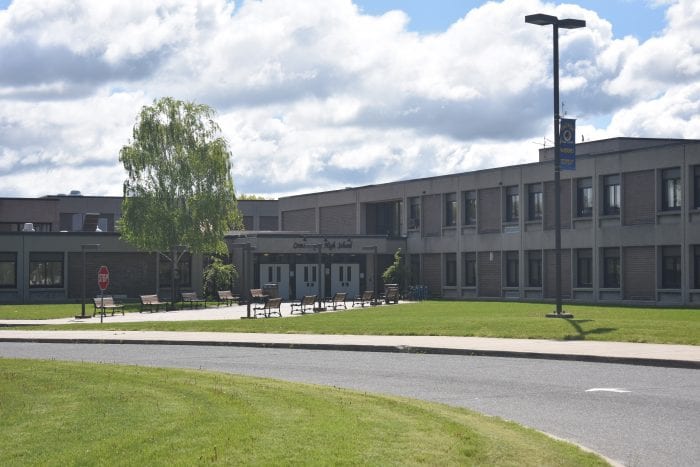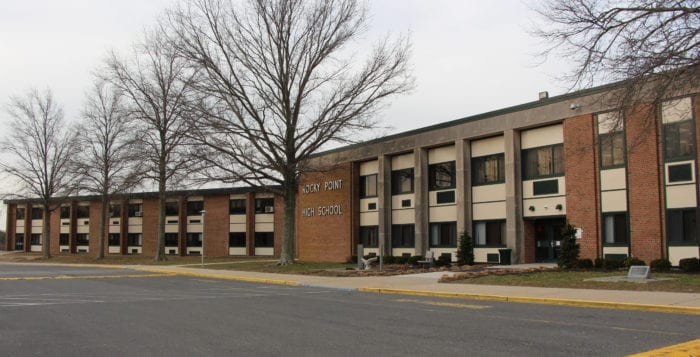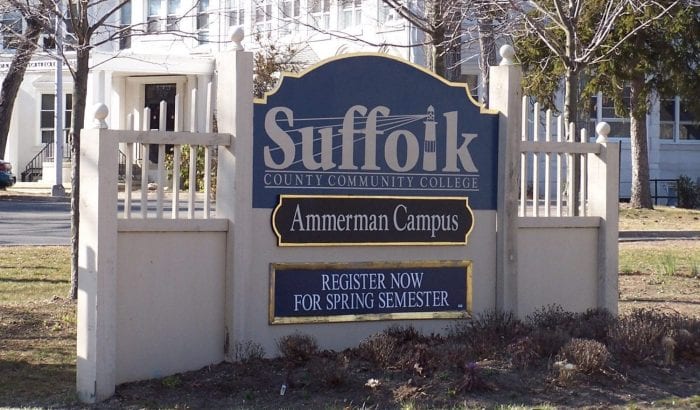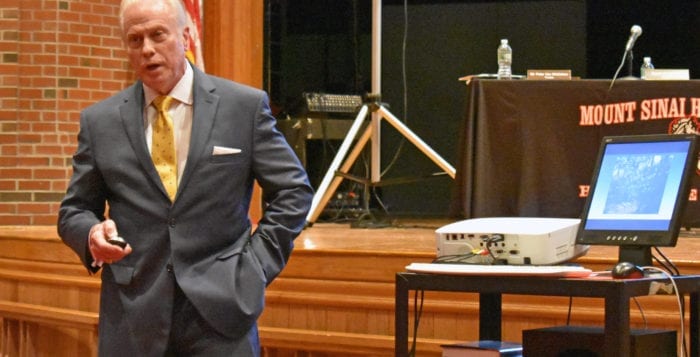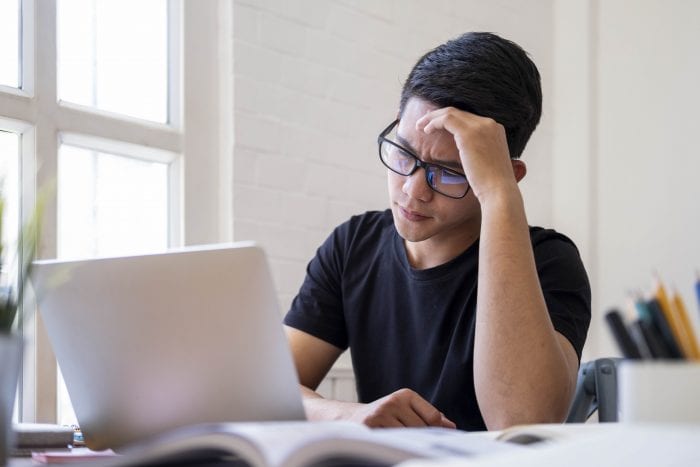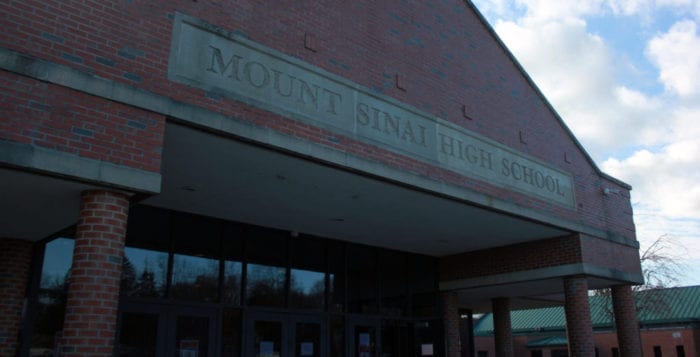Reopening
Comsewogue to Remain with Current Learning Plan Through Next February
Unlike other neighboring districts, Comsewogue is holding off on plans to bring more kids into school until late February or early March, citing the steadily increasing COVID-19 numbers on Long Island.
Superintendent Jennifer Quinn said the decision was made partially based on a survey released to both parents and students as well as by the reopening committee that comprises staff, parents and students. She said the Suffolk County Department of Health also suggested now was not the best time for bringing in more students.
“We said since the beginning, our plan is fluid,” she said in a phone interview. The district has changed several things since schools opened in September, including accepting rapid testing where initially the district was wary of the tests’ veracity, bringing back music class, hot lunches and allowing more students to use playground equipment and have more students together during gym.
In the November survey for district residents, the results of which were posted on its website, Comsewogue got responses from a little under 750 students. Of those, 88% said their mental well-being was average or better, on a scale of 1 to 5.
As for remote work, survey results show about 40% of students spend more than three hours on remote work a day, while 30% say it’s two-to-three hours, and about a quarter of students said they spend less than that. The vast majority of students said an earlier deadline on remote assignments would not make life easier.
The district said it expects the average remote workload should be between 3.5 and 4.5 hours, excluding AP classes. District officials said the survey results show they are doing the best job they can under the circumstances.
“We don’t want our students staring at the computer screen all day,” said Jennifer Polychronakos, assistant superintendent for instruction.
A total of 40% of students said they would be comfortable returning to in-person learning without social distancing and masks, while 60% percent said “no” or “not at this time.”
The district also got responses from 160 district parents, of which almost 90% said their children are coping with current learning standards, based on a scale of 1 to 5.
Around 70% of parents said they would not like to see students return to school without masks or social distancing.
Quinn said the question was composed to effectively say the district could not hold students in-person all at once and still maintain social distancing.
Other schools are pushing ahead with reopening plans. The Port Jefferson School District has tentatively set an early January date for bringing students in for four days a week. The Rocky Point school district this week started bringing back students for four days of in-person learning.
At Comsewogue, Quinn said she and other people on the reopening committee are concerned about rising COVID infection rates and hospitalizations. Back in July, New York State set the limit that the infection rate could be at to reopen was 5%.
The superintendent cited Dr. Anthony Fauci, the nation’s top infectious disease expert, who said Sunday, Nov. 29, the U.S. was expecting a difficult Christmas time in terms of both COVID-19 infections and related deaths.
“The risk of making someone sick is a concern for us right now,” Quinn said. “You listen to Dr. Fauci who said our country might be closed — I want to keep our schools open.”
The district is hosting a board of education workshop Dec. 3 where the superintendent said in a call to parents, they will be discussing what the district will do if the area is designated a yellow zone by Gov. Andrew Cuomo (D), entailing 20% weekly testing of in-person students and faculty in schools. The next board meeting is scheduled for Dec. 7.
Rocky Point Goes to Four Days In-Person Learning
Other Nearby Districts Revise Protocols/Quarantine Students
Rocky Point schools have moved to keep students for in-person learning four days a week.
Starting Nov. 30, Rocky Point middle and high school students are to go to school Monday, Tuesday, Thursday and Friday, with Wednesday remaining as a dedicated virtual day.
The decision to push this part of the reopening plan to after Thanksgiving was made earlier this month, Nov. 4, according to a letter to parents signed by Superintendent Scott O’Brien.
“What is most important is that any change we make is done carefully, and with health and safety at the forefront,” O’Brien wrote in his letter.
The live-streaming component of what the district called “Phase II” began Nov. 9 to log into a period-by-period class schedule.
Those students who are switching to virtual from in-person learning, or vice versa, also have a start date of Nov. 30.
“With a recent increase in the number of positive COVID-19 cases in our district and the surrounding area, it was necessary to reallocate our transitional resources to address cleaning and disinfecting due to recent positive cases,” O’Brien wrote in his letter.
Since September, Rocky Point has seen 25 students test positive for the coronavirus while nine staff/teachers also tested positive as of Nov. 30, according to the state’s COVID Report Card.
Other neighboring districts have similar rates of infection, with school districts overall having much lower infection rates than the general populace. Shoreham-Wading River, with its plan of having students in school five days a week resulting in an infection rate of 1%, that currently being 22 students and six staff members.
The SWR district did have to close the high school and quarantine over 100 students and several staff members a month ago after two students who allegedly attended some kind of social gathering tested positive.
Still, Superintendent Gerard Poole said in a letter posted to the district website that they have revised protocols so that schools will not be closed the day a positive case is reported if contact tracing can be performed in time, along with the needed cleaning and disinfecting.
“The intent of this revision is to reduce the number of school closures,” Poole wrote. “Please know that the decision to keep a school open, as opposed to closing for a day, will always be made carefully with the health and safety of our students and staff as the priority.”
Meanwhile in Miller Place, the district said Monday the district contact traced three Miller Place High School students, one North Country Road Middle School student and one staff member from there who have all tested positive for COVID-19. None were symptomatic when last in school, and all have since been quarantined.
Miller Place Superintendent Marianne Cartisano said in a letter posted to the district website that the positive cases were relayed to the district through the Safe School Helpline.
“We have also been working with multiple staff members and community families who have been identified as close contacts of persons testing positive for COVID-19,” she wrote. “If required, staff have been quarantined as close contacts.”
PJSD Board Votes to Return to Four Days of In-Person Learning Jan. 11
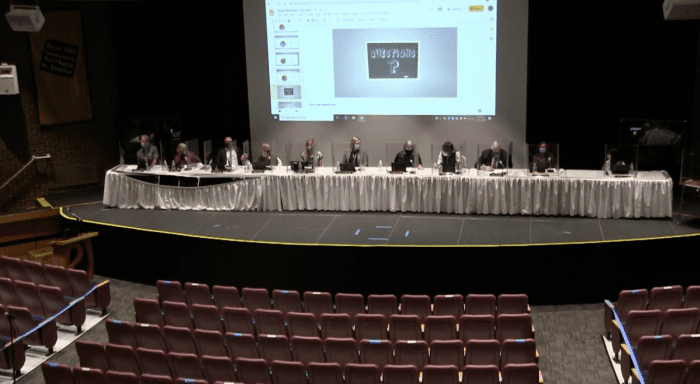
In its Nov. 10 meeting, the Port Jefferson School District Board of Education decided to open up the middle and high schools for more in-person learning starting in January, though plans may be complicated by rising infection rates.
The board voted 4-3 against a plan to start rolling in students on a staggered, weekly basis Dec. 8. The board then voted 5-2 to have all students in grades six through 12 start back Jan. 11. Trustees Rene Tidwell and Ryan Walker both voted “no” on the plan.
Superintendent Jessica Schmettan said this would also mandate the installation of desk shields. The district already authorized the purchase of desk shields at $135,000. Those shields are expected sometime around the third week of November. In addition, ICT students will begin four-day instruction immediately.
In this plan, Mondays would remain a remote-learning day with office hours and asynchronous instruction. Tuesday through Friday would then become in-person for all students. Desks and desk shields would be sanitized at the end of each school day, and then on Mondays any lingering haze left from the sanitizer would be removed.
“We got a lot of parent feedback as to why 11th-graders should be in as it helps their college careers, why middle school students should be in — we recognize that all students benefit from in-person learning,” the superintendent said. “The how and the when is something we’re having a lot of discussion on.”
She said it would take from five to 10 days to install all desk shields in the two schools.
A survey of 513 parents in the district revealed that just over 88% said they would like to send their child to four days of instruction. Another 7%, or about 36 families, said they were using the full remote option and would continue that way.
In that same survey, 65% of parents said they would like to see students go to four days as soon as possible. While other families wished the district to start this plan in January or February, a little over 10 percent, or about 56 families, said they wished the school to continue with the hybrid model.
Almost 60% of parents surveyed want children to return all at once, while another 24% want kids phased in with smaller groups.
Students were similarly polled, and most, just over 67%, also wanted to be back in school four days a week, though only 42% said it should be as soon as possible.
While most school staff would like to see children back in school for more days, just a little over 50% of the 94 surveyed want to see students brought in with staggered groups.
A representative from the Port Jefferson Teachers’ Association also spoke at the meeting, asking the district to bring in experts from local hospitals when considering reopening, and mentioned the district would gain little if it brought back students after Thanksgiving, as it would only be a limited number of days before Christmas.
“Overwhelmingly, our staff want our kids back in the building — they want them back four days a week,” the superintendent said. “The biggest question becomes how and when.”
Tidwell expressed some concerns over how well students will be protected by the desk shields, noting that they do not necessarily stop all of the aerosolized virus. She said it’s likely to also see upticks in cases after the holidays, and the district should hold off until after December or after the holidays.
“We can’t ignore what’s happening in Suffolk County,” she said.
Currently, the infection rate in New York has breached 3%, higher than any other time it’s been in the past few months. Suffolk County Executive Steve Bellone (D) has said the jump in infections may be because of Halloween, but state officials also blame restaurants that sell alcohol, gyms and home gatherings. New restrictions are already in place.
Walker said he trusts the administration to do what needs to be done, but the board would have to be conscientious before the decided date. He said he would like to see the school district go ahead with these plans.
“My position really hasn’t changed,” he said. “When we come up with a date, we look at the data immediately preceding that date to see if it’s safe. If we don’t think it’s safe, we’re not going to go ahead with it. What I worry about though, if we do decide on a date, if nothing changes from where it is currently … are we then going to push the pause button again and again and again? If you’re not secure in sending your kids in now, I don’t think possibly you’re ever going to be secure in bringing in your kids.”
Board vice president, Tracy Zamek, said the toll of keeping kids in this current model is doing harm.
“Our kids are not doing well, in my opinion,” she said. “If the school is ready and the numbers are OK, then we need to get the kids back in.”
Assistant superintendent, Christine Austen, said the schools’ social workers are working on reports for how students are currently doing.
Schmettan said other districts in the area have set dates and then pushed back those dates, and they could do the same thing.
“The really difficult part, we can set that date for whatever the date may be but infection rates, closures — things are going to change,” she said. “Regardless of whatever benchmark or milestone we shoot for, there is a possibility it is diverted.”
Mount Sinai Parents Demand More Days of Instruction at School Year’s Start
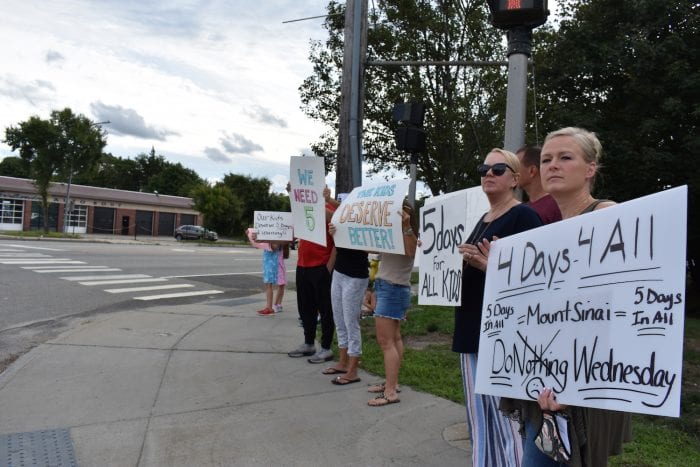
As the impending start to the school year closes in, some parents in districts like Mount Sinai are trying to close what they perceive as gaps in schools’ upcoming learning programs.
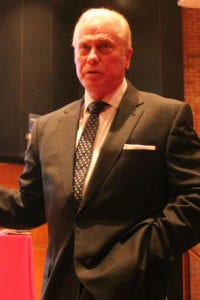
A small group of Mount Sinai residents consisting of parents and a few of their children protested at the school campus entrance on Route 25A Monday, Aug. 31, arguing their school district’s current reopening plans could lose students days’ worth of instruction time. Meanwhile, district officials allege plans will likely change in the future, and they are doing their best to move to a system for five-day full-time instruction for elementary students and more in-school days for secondary students.
Elle Bee, who has three students in the district — a kindergartener, elementary and middle schooler — said the district has not been communicative enough with her and other parents about their concerns, especially over what the district plans for Wednesdays. They also claimed that their questions and concerns have not been fully answered by the school administration.
“We want actual distance learning,” Bee said. “We would like to return to four days or five days in school.”
Current district plans have all students out of school on Wednesdays in order for the custodians to fully sanitize each building. Teachers will be using that time to communicate with students, especially the 50-odd children per building that will be learning remotely full time, though students will still be required to log on to the school’s Google Classroom. Parents at the small protest said that if this standard lasted all year it would result in students losing upward of 40 days of learning, which would be less than New York State requirements for the total number of instruction days of 140.
Kevin Mathers, who has a seventh-grader in the middle school, said he finds it absurd that the district will not even attempt at least a true remote experience on Wednesday.
“Any plan that includes not teaching on Wednesdays is a nonstarter,” he said.
Superintendent Gordon Brosdal said in a phone interview there will be some instruction on Wednesdays. Teachers are going to be constructing videos and lessons for both that day and for all remote days. Instructors are also supposed to touch base with all the remote students whose parents chose to keep them at home. Teachers, he said, are working at the max extent that their contracts call for, and that they hope by the end of September they will be able to change it to include Wednesdays for full instruction in the elementary school and in cohorts in the high school.
“When teachers teach four days a week, when are they going to do that remote learning and ask each student, ‘How are you doing?’” the superintendent said. “When can parents reach [teachers] and visit teachers during office hours? That’s what Wednesdays are for.”
Still, this isn’t enough for the parents who stood along Route 25A. Some parents asked why the district wasn’t mandating that every teacher livestream their classes.
Brosdal said there were concerns amongst teachers, based on previous news reports, that people could break onto these livestreams and harass both students and the teachers. Though the district is installing around 160 cameras in classrooms for the purpose of broadcasting lessons for those either creating videos or, in some cases, livestreams.
Parents also complained about plans for students on buses. They said they were originally told buses would be at 50% capacity and only siblings could sit on the same seats. They argue this was changed to now allow up to 44 seats with even nonfamily members sitting together.
“They’re going to have to wear masks full time, even with guards around their desks, so how are you shoving them onto buses like sardines in a can?” Bee said.

Brosdal confirmed that buses could be at more than 50% capacity, though it’s all dependent on how students are either dropped off by their parents or walk to school. The district is limited in the number of buses their contracted company First Student has, and that it would cost the district upward of $80- to $90,000 to request that even one new one be built. Still, he is confident that buses wouldn’t be at far less than their max capacity.
Some parents were especially concerned with their students receiving special education. Alexandria Hoehl said she had four children in Mount Sinai who receive special services in the district, and she was concerned they would not get the five days of one-on-one attention they need.
My kids “are going to miss more class time when they’re in school to meet the needs of their services they get — like physical therapy, occupational therapy — which are now being squeezed into a shortened amount of time,” she said. “With my oldest, with only being in school two days, they’re going to try and fit five days of services into two days.”
Brosdal said the school is required to follow each special needs student’s individualized education program. The special-ed students will be receiving teaching four days a week and remote learning one day a week, according to the district’s plan.
Though the superintendent said he wants as much in-school instruction as possible, the problem, he said, is space, especially concerning the high school. With 800 students plus staff, the superintendent said it would be impossible to have all students learning in person four days a week and keep them distanced as required by New York State.
The high school, he added, is also very problematic when students have to move from one classroom to another between periods, as the school is designed so several hallways are linked by one larger hallway. Looking at pictures from schools out of state with kids flooded into hallways with minimal distancing, as well as news like SUNY Oneonta’s recent shutdown because of escalating COVID-19 cases on campus, Brosdal said the district needs to be careful if it ever wants to open up more broadly.
But for some parents, the possibility that things could change in a month’s time is not enough reassurance. Bee said that the virus infection rate in New York remains low, but “it’s never going to be zero — why shouldn’t we start off now and pull it back if the numbers increase, if they increase, because we simply don’t know.”
Students Return to Suffolk Community With New Guidelines
Suffolk County Community College welcomed students back for the fall semester Sept. 2 with a combination of online and in person instruction.
The college launched a Return to Campus Guidelines website to outline policies and procedures for this fall’s return. Services including the community college’s libraries and child care centers will be available to students.
In preparation for the new semester, Interim College President Louis Petrizzo said in a release, the college empaneled a Safe Start Task Force that prepared and implemented the college’s SUNY-approved reopening plan. The task force reviewed the configuration of every space that students, faculty and staff may occupy or are scheduled for use and marked them for safe, social distancing. In preparation for the semester the college’s faculty underwent additional training to sharpen their skills for remote instruction. In order to promote equity, SCCC also distributed more than 540 laptops, 300 Chromebooks and 75 Wi-Fi hotspots for student use this fall. Outdoor wireless access was also expanded to parking lots on all campuses.
“We recognize that high-quality child care is important for students who are attending classes,” said Interim President Petrizzo in a release. “Our childcare centers will reopen and be available with new drop off and pick-up procedures in place for health and safety.”
Suffolk was able to distribute more than $3.5 million in student grants under the federal CARES Act to students who suffered financial loss due to COVID-19. CARES Act funding made it possible for many students to return for the fall semester.
Petrizzo said the guidelines website is the result of months of work by the college’s Safe Start Task force which devised the plan in consultation with New York state and Suffolk County officials to ensure that students, faculty and staff that will come to campuses can do so safely.
The guidelines include a requirement that all students complete an online daily health screening questionnaire before arriving at a campus. Successful completion of the questionnaire will trigger an email to the student’s email permitting access to campus and must be shown to the Public Safety Officer on duty when arriving on a campus. Any student whose responses indicate a risk of COVID-19 exposure will receive an email advising them that they do not have clearance to come on campus that day and should contact a campus dean.
The guidelines further require that students adhere to social distancing and mask requirements. Those who don’t may face suspension.
Students attending classes on a campus will be in smaller groups to reduce density in accordance with physical distancing guidelines.
Instruction for the fall semester will be provided through asynchronous online assignments, real-time synchronous learning and a partly on campus and partly online option. There will be a limited number of face-to-face classes that will require hands-on instruction.
Campus libraries will be open and accessible by appointment. Students can reserve two-hour time-blocks by reservation using an online form. In addition, remote library research assistance will be available by phone, email and virtual chat.
The college also announced the modification or elimination of meal plan fees and credit card convenience fees. The distance education fee has been modified to be a one-time charge per semester, compared to a per-class fee.
PJSD Outlines Remote Option for Fall
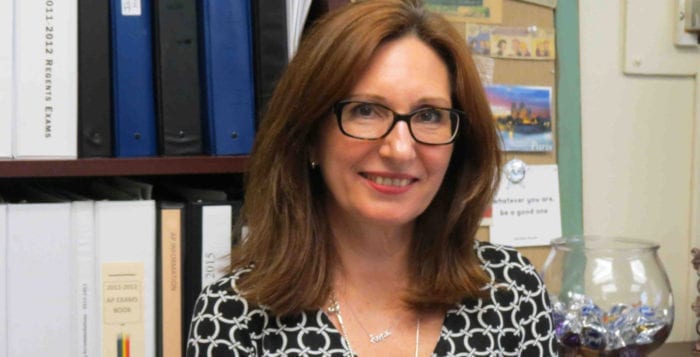
The Port Jefferson School District is exploring options for a distance learning program after an outcry from multiple parents who were concerned over the spread of COVID-19.
The district received multiple letters and petitions from parents demanding they have an option to have students learn from home instead of participating in either in-person or hybrid learning. Several letters read aloud to the board spoke of fears for elderly family members or people with health risks living in the same home, and the risk their kids may spread the virus if they attend school regularly. Many of these petitions were read at the school board’s Aug. 11 meeting.
According to the district’s survey of parents, 15 percent said they would not return their students to in-person instruction. Of those, 97 percent said they would be interested in a remote learning option.
The district said that parents of 95 students, most of whom were in elementary school, were interested in a remote option.
Of those who were concerned about kids returning, Assistant Superintendent for Curriculum & Instruction Christine Austen said the number one fear was concerns of social isolation.
A number of the options were costly, according to Austen, who said a full school year BOCES online program could cost approximately $1 million if it were supplied to all 95 students. Some parents did indicate they were willing to homeschool their child.
Every child will be granted a Chromebook, whether they are in school or be taking remote learning. Students will have synchronous instruction three days per week, with students in the middle and high school following their in-person schedule period by period. Students will have another two days of asynchronous instruction for assignments or projects or recorded videos. Teachers will be in the physical classroom every day. Students will also have daily check-ins to ensure attendance.
Austen said the plans for elementary students are still tentative, but plans are currently for them to be given about one hour of English and one hour of math in the morning. They will be given some time to meet with teachers before lunch, then later have time for social studies or science lessons. Teachers will host small group instruction for remote students at the end of the day.
The Google learning platform will be standard throughout the district, and teachers have been taking professional development to better use the platform.
Superintendent Jessica Schmettan said the district must work with teachers to conform with what their union contract allows them to do.
“Teachers have worked very hard this summer, a lot of these ideas come from the teachers,” said elementary Principal Tom Meehan. “Some of the ideas were really good, and I have to give them all the credit in the world.”
Still, the district said all plans are tentative, and more comments will be accepted up until the first day of school.
The district hosted meetings for elementary, middle and high schoolers and parents specifically about their kids’ return to schools. All videos are available from the district’s website. School is set to start Sept. 8.
Districts Craft Plans for Distance Learning Options
While some districts came out with their reopening plans last month, parents across the North Shore sent letters and petitions to district officials demanding to have some kind of distance learning option.
Several weeks later, school officials have come out with details about some of these initiatives. A few are hosting efforts in house, while others are offering the option of using a BOCES-run program.
Rocky Point
Rocky Point Union Free School District will offer a five-day 100% remote model for K-5 students after parents in the area pleaded to at least have the option.
The district already presented its plans to have elementary students in school full time. In a letter posted to the district website Aug. 14, Rocky Point describes the distance program as a blend of synchronous or asynchronous learning. This will either be handled by Rocky Point staff or through enrollment in the Eastern Suffolk BOCES Online Elementary Program, which will include students from other districts as well. Schedules will align with what they would be doing if they were in-person, though parents need to commit to distance program for the full school year, September 2020 through June 2021.
Parents must fill out a form that is available on the district website by 3 p.m. Aug. 20.
The district was also set to unveil plans for a remote option for students in grades 6-12 Wednesday, Aug. 19, but those plans were not available by press time.
Miller Place
In a letter to parents Aug. 12, the Miller Place School District showed off its plans for remote instruction for K-5 and 6th grade students. The district does not currently have plans to offer a full remote option for students in grades 7 through 12, and their model remains hybrid-only.
The district will offer students who enroll in the remote learning program live instruction five days a week, with days lasting between five and five and a half hours each day. Instruction will also include the normal set of English, math, writing, physical education, art, music and social and emotional learning.
Parents will need to commit to this option for the entire school year running from September 2020 through June 2021. Students cannot choose to reenter the normal 5-day schedule if parents choose this option.
Students will also either be assigned district staff or be enrolled in the Eastern Suffolk BOCES Online Elementary Program in a cohort of students which will likely include kids from other districts.
Parents should have already emailed district personnel in order to access the program. Parents with questions can email [email protected] for more information.
The district said it is unable to offer a remote program at the middle and high school level, as they said they do not have the resources to mirror the new course offerings with a remote program. The district also claimed it does not have the legal authority to livestream classes to students at home, saying that cameras are not allowed in classrooms during instruction.
“From a legal standpoint, it is considered discriminatory, and not equitable, to offer courses to in-school students and not have those same courses available to remote learning students,” the district said in its statement. “The district is not willing to reduce or eliminate course offerings, including electives, for in-school students, in order to accommodate families requesting remote learning for non-vulnerable students.”
Mount Sinai
The Mount Sinai school board has said its intent to allow parents to participate in a full-time remote program. The district is planning to have a remote instructional model for all grades K-12, and parents must sign an intent form available on the district website if they intend to full remote instruction.
The district plans to use Google Classroom as the main platform for remote learning. Attendance will be taken daily through the platform.
“Parents should be aware that if they choose to opt-out their child from attending in September, the window for returning to school would open in January, the beginning of the second semester,” Superintendent Gordon Brosdal said in the Q&A available on the district’s website.
For elementary students who participate in remote learning, there will be videos recorded by their designated classroom teacher posted four days per week on the teacher’s Google Classroom page. Students will have the opportunity to interact with their teacher on Wednesdays when the students participating in in-person instruction are not in session. Teachers will also be available via email throughout the week to answer questions. Students will be given the same workbooks as their in-person counterparts and will be offered physical education, art and music content one day a week Monday, Tuesday and Wednesday.
For remote students in the middle and high schools, teachers will post videos and other assignments to Google Classroom in line with schedules as if they were in school.
“Simply put, remote learning is not the same as in-person instruction and students must be actively engaged in learning when they are not in school,” the district’s remote learning document stated. “Teachers will make every effort to ensure that students are provided ‘live’ instruction as much as possible.”
Teacher videos and assignments will be posted as soon as practicable when lessons take place, which the district said will “allow teachers to continue with the curriculum without interruptions.”
Shoreham-Wading River
The SWR school district has not released any plans for a remote option for students of any grade level. If a parent currently wishes to not have their students in school, then they must be unenrolled and instead be homeschooled.
The district has adopted a plan that would have every student in school five days a week for in-person instruction, all while meeting New York State Department of Health guidelines for distancing and controlling the spread of COVID-19. The district also plans to reopen the Briarcliffe school for kindergarten students.
At the districts board of education meeting Aug. 18, Superintendent Gerard Poole related more details about how the district would take temperatures of students and allow them to board and exit buses without being in contact with other students. Poole also clarified that students will need to be wearing masks at all times unless in a setting where 6-feet distancing can be maintained.
The district does have a remote learning plan in place should the school need to close at any time during the school year.
SBU’s Nachman Offers Health Advice for Returning College Students
People are using too much hand sanitizer. That’s one of several observations from Sharon Nachman, chief of the Division of Pediatric Infectious Diseases at Stony Brook Children’s Hospital.
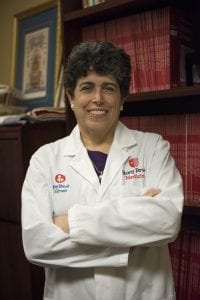
Nachman suggests that sanitizer requires only a small amount on people’s hands. If, after applying it, someone has wet and sticky hands, they have overdone it.
“When I see people using hand sanitizer, they glop it on,” Nachman said in an interview. She recommends not using more than the standard volume, even amidst a return to school during the ongoing fallout from the COVID-19 pandemic.
In a wide-ranging conversation about the health of students who are returning to campus, Nachman urged students to pay closer attention to their health, to keep themselves and their classmates safe.
Students can tell if they’re too close to each other if they both reach out and can touch each other’s fingers.
The signs of COVID-19 in older teenagers and young 20-somethings are similar to the ones that occur in adults. They include fever, fatigue, feeling ill, loss of taste, and dry coughs. College students also have a high rate of being asymptomatic, which makes it difficult to find and isolate sick students.
While multi-symptom inflammatory disease in children, or MSI-C, cropped up during the worst of the pandemic in Suffolk County, the overall numbers of cases and infection rate on Long Island have fallen enough to reduce the likelihood of this COVID-related illness among children.
“Its all about how big the hit is in the community,” she said. “If you go to Texas or Florida, they are clearly seeing it. On Long Island, we aren’t seeing it” because of the way residents have helped flatten the infection curve among the population.
Nachman urged college students to be responsible when a contact tracer reaches out to them. In college campuses throughout the country, contact tracing will help mitigate the spread of the infection by quarantining people who might have been exposed to an active form of the virus. Isolating people will keep the spread of the virus in check.
Students, faculty and university administrators are well aware of the possibility that schools will need to return to an all-remote education model if infections reach a high enough level. Indeed, Nachman urged students to develop a plan for what they would pack and take home and where they would go if campuses closed. By being prepared for change, students can react to altered circumstances. High school students also need such preparation, in case any school that open need to close to protect students, faculty and staff.
As for the potential overlap of the flu and COVID, Nachman suggested students should get the flu shot by October, before the flu season begins.
Nachman is an advocate for masks.
“The smartest thing people can do is really wearing their masks,” she said. “Come to college prepared with enough masks that you can wash and wear them.”
The ideal number of masks is nothing fewer than two per day. She likes the washable ones, which are easy to put in the laundry and wash with the rest of a student’s clothing. The two-ply cloth masks work well and can be “personalized to reflect someone’s mood, to match clothing or to make a statement.”
Masks are important not only to protect other members of the student body, but also to protect the wearer.
Mount Sinai Displays Full Hybrid Model for Reopening
The Mount Sinai School District released its preliminary reopening plans July 31, and though documents state the district would prefer to have all students in school five days a week, it has instead put forward a hybrid model for all students in grades 1 through 12.
Documents state that Mount Sinai simply does not have the building space to comply with New York State guidelines on remaining six feet apart. All students will be put into two cohorts separately in the elementary, middle and high schools. Cohorts will be alphabetically based in order to keep students in the same family going in at the same time.
Monday through Tuesday and Thursday through Friday will be taken up by one of the two cohorts, and all students will share Wednesday for remote learning.
Meanwhile, students in kindergarten will be able to attend in-person four days a week, with remote learning one day a week. In the elementary school, each room will need to be thoroughly disinfected in between cohorts usage.
Students in special education which normally learn in “self-contained classrooms” will be able to attend in-person instruction four days a week, with remote learning one day a week.
Kindergarteners will be assigned to classrooms of 18 to 20 on average, which the district said it should be able to do with current accommodations. For Grades 1 through 4, students will be placed into cohorts of 10 to 15 students depending upon the physical size of the classroom. This will be accomplished by taking a traditional classroom of 20 to 25 students and splitting into two groups alphabetically. The elementary school will prevent intermingling across cohorts by limiting movement of the cohort throughout the day. The only movement of the cohort will be to lunch and potentially physical education. Faculty may travel in and out of the classroom for art and music instruction.
During remote learning, the district said attendance will be taken through Google Classroom recording a student’s logon. Remote learning may consist of synchronous, with a teacher present live online, and asynchronous instruction dependent upon the course or teacher.
Teachers are also expected to communicate with parents weekly, for elementary students, and biweekly for parents with kids in the middle and high school.
In order to attempt to maintain social distancing, the district will put signage and markings on the floor to designate traffic in the hallways and for standing on lines in places like the cafeteria.
Cohorts in the middle and high school will be broken up into last names starting with A through Kh and Ki through Z. Music lessons will be created within each cohort group. Students will also be assigned one of several doorways in each building to both enter and exit the school, and no student is allowed to use their gym or hallway locker, and they will often rely on online textbooks.
Upon arrival, students that do not have the required proof of temperature from home will be directed to a screening area. The district will conduct temperature checks outside the building at a designated location upon arrival via touchless thermometers. If the student has a temperature above 100 degrees, the nurse will be called by radio to escort the student to isolation waiting room for pick up.
The district’s survey showed that out of 1,085 responses, 86 percent said they would send their children to school for in-person instruction in the fall. 66.5 percent said they would need to use buses for transportation.
Still, some number of respondents said they would require district help. Approximately 112 respondents said their child does not have access to a computer, tablet or laptop for use in the online component.



